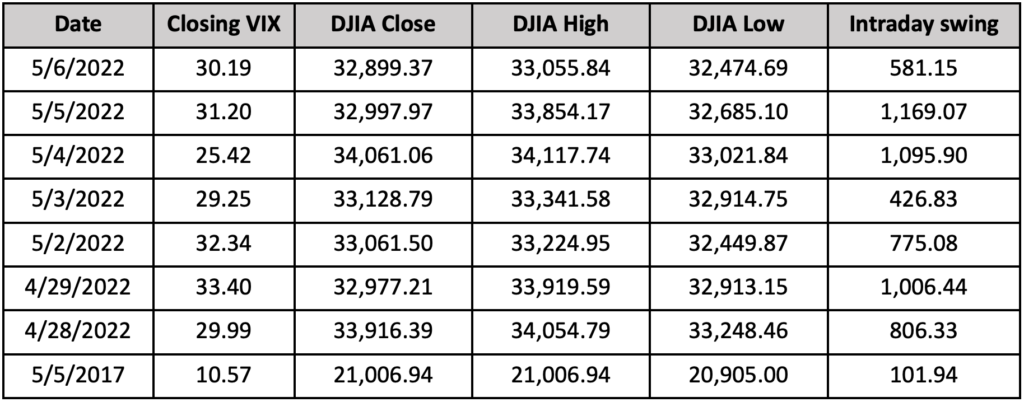Tax Deadline Approaching The 2023 tax season is underway, with the filing deadline approaching on April 15, 2024. […]
In early April, Summit published a newsletter in which we discussed the challenging 1st quarter for investors, and our recommendation to follow the discipline of your Investment Policy Statement. The recent market volatility and accompanying news headlines provide us with good reason to reaffirm our guidance and share some perspectives of the current investment environment.
During periods of elevated volatility, short-term performance tends to be erratic.
The VIX level is the most frequently used proxy for stock market volatility. A reading of 30 on the VIX is viewed as market participants pressing a panic button. When that happens, investors tend to react accordingly and we are seeing it in recent trading sessions. Through Friday, May 6th, the VIX was above 30 for most of the previous 8 trading sessions and major stock indexes swung between significant losses and significant gains.
The higher the VIX measurement, the bigger the up and down swings tend to be. It is useful to note that the VIX is a raw number derived from a range of call and put strikes of consecutive options expiring in 30 days.
We believe elevated fear levels may remain for the near-future, and we have constructed portfolios to withstand such challenges. Investors are facing what feels like “bigger-than-normal” unknowns and the magnitude of future market reactions will be based on whether news is better or worse than expected in relative terms, not whether it is good or bad news in absolute terms. Concerns over inflation, a Federal Reserve policy error, rising interest rates, ongoing war in Ukraine, China’s zero-Covid policy, a disappointing Q1 2022 US GDP report showing a 1.4% contraction, and poor economic activity in Europe have weighed on investors’ sentiment and confidence. However, despite current headwinds, S&P 500 earnings have grown about 5% year-over-year even while stock prices have fallen.
Elevated fear levels do not last forever. Although stock values often “zig” when the VIX “zags” in the short-term, equities tend to rise as companies increase their earnings and the VIX subsequently reverts to the mid-teens. We have experienced VIX spikes before, and adhering to an Investment Policy Statement established prior to periods of high volatility has generated good outcomes over time.
Investors feel the pain of losses more acutely than they appreciate gains, which clouds perspectives.
We know from various behavioral finance studies that most investors experience the pain of losses somewhere between 2 and 2.5 times more than they appreciate gains. We also know that people tend to be hard-wired to avoid negative surprises, as evidenced in psychology experiments where volunteers will choose to receive a greater number of strong electrical shocks at regular intervals rather than a smaller number of shocks at random intervals. With awareness of these preferences, we appreciate how difficult market volatility can be on an investor’s psyche and confidence, so we hope some additional perspective will be useful.
If digging into the VIX wasn’t enough, we have another important (at least to advisors!) risk-management measure known as Value-at-Risk (VaR). Those who work with VaR accept that it is backward-looking and has limitations, but it also provides an interesting lens for assessing how unsettling days like last Thursday, May 5th measure in historical perspective.
The daily VaR at a 1% confidence level is the data we use for comparison to show just how bad May 5th was for the major stock indices…

If you were thinking “It doesn’t get this bad very often…” you would have been correct. Historically, 1% of trading days have seen losses of 3.28% or worse for the DJIA, 3.40% or worse from the S&P 500, and 4.88% or worse for the NASDAQ. Both the S&P 500 and NASDAQ edged into the 1% VaR range on that day and the DJIA was pretty darn close at -3.04%.
We can further review volatility by examining the intraday swings in the DJIA over the past several trading sessions and compare them to 5 years ago to see the impact of a high VIX versus a low VIX. For as wild as the May 2022 trading sessions have been (average intraday swings of 809.61 points), the 5/6/2022 closing average was only 77.84 points below the final closing price in April (or -0.24% from the starting point!).
If you were a character in a soap opera who went into a coma at 4PM on April 29th and woke up at 4PM on May 6th, you would see less than 78 point difference in the DJIA and assume nothing much happened in the stock market while you were asleep. However, if your coma had begun on 5/15/2017 and lasted 5 years, you would have awoken to a stock market that had generated substantial gains. How much? Well, the growth in the DJIA index value averaged about 9.5% per year, and if we calculated a total return incorporating the dividends and impact of stock splits and buybacks, investors earned a 12% annual average gain for those 5 years.

In summary, we pay attention to what is going on day-to-day in investment markets – in part so that you can spend your time and energy paying attention to the things you love and care about. In following the market developments, we look for rebalancing and tax loss harvesting opportunities, avoid over-reactions, maintain the discipline of your Investment Policy Statement, and provide guidance to make appropriate long-term decisions. As always, Summit team members are available to you to discuss your personal situation or concerns.
Quick Links
| About Summit | Important Disclosures | Access Your Portfolio Reports | Investment Philosophy Presentation |
Read More:
